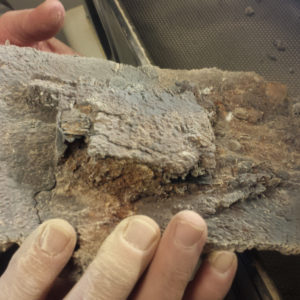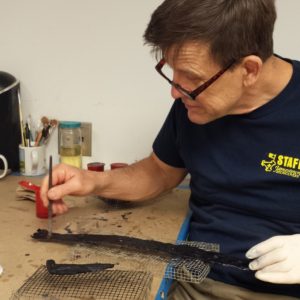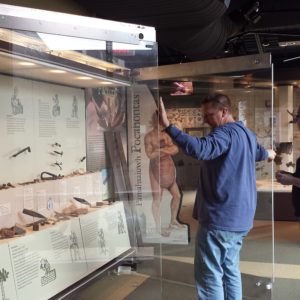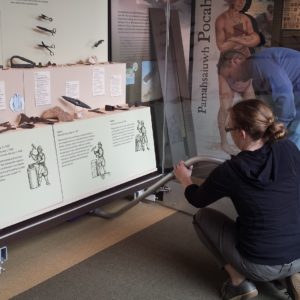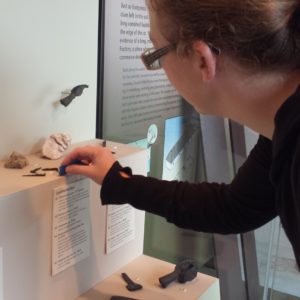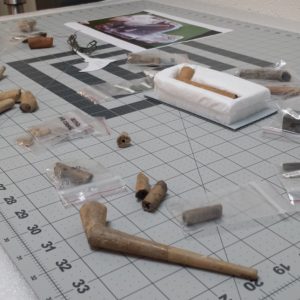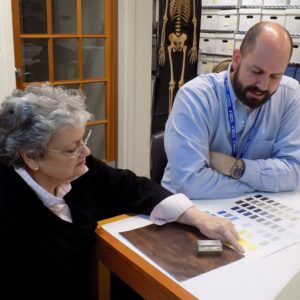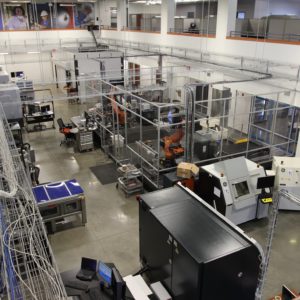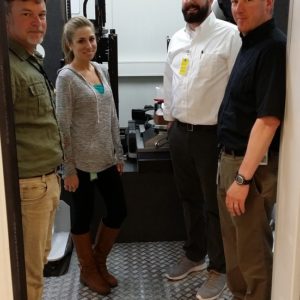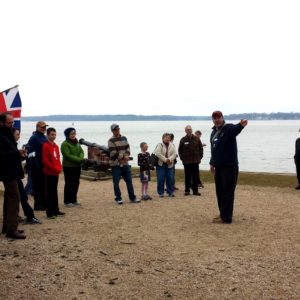This month, the Rediscovery conservation team focused on iron objects recovered from the cellar excavated in 2015. While several large pieces of armor were found, many non‐military related objects were also recovered. Senior Conservator Dan Gamble is currently air‐abrading a large lock plate found in the same layer as the armor. Gamble explained that X-rays of the heavily corroded lock plate revealed very little good metal, thus he must be extra careful in removing the corrosion. Several other door hardware objects were uncovered, including a large door hinge with pintle, which is being conserved by Assistant Conservator Don Warmke.
For several days, Rediscovery conservators also performed maintenance duties in the Archaearium. This periodical task includes changing light bulbs in exhibits, cleaning the exterior and interior of display cases, and assessing the condition of the exhibited artifacts. One misconception about the objects we find is that once an artifact is stable enough to go on display, its conservation is complete. Conservation, however, is a continuous process that never ends, even after the artifacts are exhibited.
Many senior staff members are immersed in planning a couple of new exhibits for the Archaearium. One exhibit will concentrate on influence and industry in the colony, and one of the new display cases will highlight tools used by Jamestown’s pipe maker, Robert Cotton, who arrived in 1608. The second case will feature tobacco pipes made by Cotton, which are stamped with the names and initials of early colonists and Virginia Company investors. Another exhibit will feature new discoveries on religion in early Jamestown, which were illuminated by the recent excavation of four burials in the chancel of the 1608 church.
Senior Archaeologist Dave Givens and Senior Conservator Michael Lavin are continuing to work with General Electric at their Customer Solutions Center (CSC) at GE Measurement & Control’s Inspection Technologies site in Lewistown, PA. We hope to unlock more secrets about the recently excavated silver reliquary box that was found on top of Captain Gabriel Archer’s coffin. Because its lid is sealed shut with corrosion, efforts to identify the contents of this unique artifact must be non‐invasive to avoid damage. Micro CT scans last year by Micro Photonics, Cornell University, and GE revealed that the reliquary holds seven human bone fragments and two pieces of a lead ampulla.
An ampulla is a small lead flask or vial acquired during pilgrimages in the Middle Ages, which contained the blood of a saint, or oil, water, or soil from a holy site. Frequently found on European and English archaeological sites, and also from London’s River Thames, ampullae often bear a symbol of the pilgrimage site or the saint whose blood it presumably held.
The Rediscovery team returned to Lewistown in the hope that one of GE’s new, state‐of the art imaging machines would reveal identifying surface decoration on the ampulla. Scanning at 450 kV ‐ a normal dental x‐ray is just 35 kV ‐ the GE team easily penetrated the object and saw, for the first time, the hollow interior of the lead vial. “To get a great image of the interior of the silver box, we had to use some pretty high power,” Givens explains. “Unfortunately, the powerful X-rays don’t stop on the surface of the object like radar waves; they penetrate on through to the detector which results in a three‐dimensional image.” Although GE’s advanced algorithms provided some of the clearest images of the ampulla yet, its surface decoration remains a mystery. Based on past experiences with GE, however, we are confident that they will develop new technologies, perhaps in the near future, which will solve our imaging challenge.
Check out the dig update video, which features Michael Lavin explaining the conservation of the silver reliquary.
related images
- Conservation of a lock plate found in the the cellar excavated in 2015.
- Assistant Conservator Don Warmke conserves a hinge and pintle found during the excavation of the cellar in 2015.
- Senior conservator Dan Gamble cleans dust off the top of a display case in the Archaearium. Gamble’s pose matches well with the poster of archaeologist Dave Givens in our well exhibit.
- Staff clean the case tops, vacuum underneath them, and clean all surfaces inside and outside. They check the gaskets and insure the climate within the cases is maintained.
- Corneli and Gamble clean the glass and vacuum under the cases.
- Senior Conservator Michael Lavin changes some of the light bulbs illuminating the exhibits.
- In order to remove these tiny dust particles from surfaces and avoid touching and disturbing object on display, conservator Katy Corneli employs the most scientific of tools: scotch tape.
- Conservator Katy Corneli carefully re-adheres lead glaze to this delft drug jar, which was assessed by our team during the cleaning of the Archaearium.
- Designing the layout of the display of tools used by Jamestown pipe maker, Robert Cotton.
- A close up of one of the many early pipes found at Jamestown that were made by early pipe maker, Robert Cotton.
- Senior staff Merry Outlaw, Jamie May, and Michael Lavin discuss plans for one of the new exhibits for the Archaearium.
- Curator Merry Outlaw and Conservator Michael Lavin discuss a new exhibit. Every detail from wall panel colors, text, illustrations, case sizes, and design, to the artifacts is carefully considered by Rediscovery staff.
- General Electric’s Customer Solutions Center (CSC) at GE Measurement & Control’s Inspection Technologies site in Lewistown, PA.
- Senior Archaeologist Dave Givens and Senior Conservator Michael Lavin at GE.
- Jamestown Rediscovery Educator Mark Summers gives a tour in James Fort’s east bulwark.



